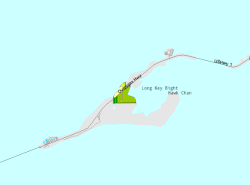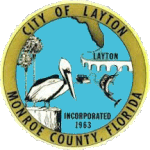
Layton, Florida

Layton, Florida | |
|---|---|
 Downtown Layton as seen from US 1 looking south along the road | |
 Location in Monroe County and the state of Florida | |
 U.S. Census Bureau map showing city limits | |
| Coordinates: 24°49′36″N 80°48′50″W / 24.82667°N 80.81389°W | |
| Country | |
| State | |
| County | |
| Settled (Long Key Settlement) | Late 1800s–1910[1] |
| Incorporated (City of Layton) | September 18, 1963[1][2] |
| Government | |
| • Type | Mayor-Council |
| • Mayor | Bruce Halle |
| • Vice Mayor | Gregory Lewis |
| • Councilors | Yesenia Diaz, Philip Porter, Cindy Lewis, and Susan Grant |
| • City Clerk | Mimi M. Young |
| • City Attorney | Dirk Smits |
| Area | |
| • Total | 0.22 sq mi (0.58 km2) |
| • Land | 0.16 sq mi (0.42 km2) |
| • Water | 0.06 sq mi (0.16 km2) |
| Elevation | 3 ft (0.9 m) |
| Population | |
| • Total | 210 |
| • Density | 1,296.30/sq mi (499.47/km2) |
| Time zone | UTC-5 (Eastern (EST)) |
| • Summer (DST) | UTC-4 (EDT) |
| ZIP code | 33001 |
| Area code | 305 |
| FIPS code | 12-39725[5] |
| GNIS feature ID | 0285408[6] |
| Website | www |
Layton is a city located on the island of Long Key in Monroe County, Florida, United States. The city is part of the Florida Keys. The population was 210 at the 2020 census.[4]

History

In the late 19th century, Long Key was used as a coconut plantation. By 1910, Layton was becoming famous as a fishing destination, thanks in part to promotion by sportswriter, Zane Grey. However, the developing tourist infrastructure on Long Key, including a station on the Overseas Railroad, was largely destroyed by the Labor Day Hurricane of 1935.[1]

After World War II, Mary V. Layton (1907-1993) and Delbert “Del” Layton (1906-1987), who ran a grocery business in Miami, bought 40 acres (160,000 m2) on Long Key and started developing the property as "Layton's Long Key Fishing Camp", which grew substantially over the succeeding years.[1]

The City of Layton was officially incorporated on September 18, 1963.[1][2] The land that would become Long Key State Park was acquired between 1961 and 1973; the park opened on October 1, 1969.[1]

Geography
The approximate coordinates for the City of Layton is located along U.S. Route 1 at 24°49′36″N 80°48′50″W / 24.826669°N 80.814006°W.[7] Via US 1 it is 66 miles (106 km) northeast of Key West and 88 miles (142 km) southwest of Miami.

According to the United States Census Bureau, the city has a total area of 0.22 square miles (0.57 km2). 0.16 square miles (0.41 km2) of it are land and 0.06 square miles (0.16 km2) of it (27.03%) are water.[3]

Climate
The City of Layton has a tropical climate, similar to the climate found in much of the Caribbean. It is part of the only region in the 48 contiguous states that falls under that category. More specifically, it generally has a tropical savanna climate (Köppen climate classification: Aw), bordering a tropical monsoon climate (Köppen climate classification: Am).[8]

Demographics
| Census | Pop. | Note | %± |
|---|---|---|---|
| 1970 | 100 | — | |
| 1980 | 88 | −12.0% | |
| 1990 | 183 | 108.0% | |
| 2000 | 186 | 1.6% | |
| 2010 | 184 | −1.1% | |
| 2020 | 210 | 14.1% | |
| U.S. Decennial Census[9] | |||
2010 and 2020 census
| Race | Pop 2010[10] | Pop 2020[11] | % 2010 | % 2020 |
|---|---|---|---|---|
| White (NH) | 158 | 165 | 85.87% | 78.57% |
| Black or African American (NH) | 4 | 2 | 2.17% | 0.95% |
| Native American or Alaska Native (NH) | 3 | 0 | 1.63% | 0.00% |
| Asian (NH) | 4 | 0 | 2.17% | 0.00% |
| Pacific Islander or Native Hawaiian (NH) | 0 | 0 | 0.00% | 0.00% |
| Some other race (NH) | 0 | 0 | 0.00% | 0.00% |
| Two or more races/Multiracial (NH) | 2 | 2 | 1.09% | 0.95% |
| Hispanic or Latino (any race) | 13 | 41 | 7.07% | 19.52% |
| Total | 184 | 210 |
As of the 2020 United States census, there were 210 people, 55 households, and 28 families residing in the city.[12]

As of the 2010 United States census, there were 184 people, 76 households, and 47 families residing in the city.[13]

2000 census
As of the census[5] of 2000, there were 186 people, 84 households, and 50 families living in the city. The population density was 860.0 inhabitants per square mile (332.0/km2). There were 165 housing units at an average density of 762.9 per square mile (294.6/km2). The racial makeup of the city was 98.92% White, 0.54% African American and 0.54% Asian. Hispanic or Latino of any race were 2.15% of the population.

In 2000, there were 84 households, out of which 15.5% had children under the age of 18 living with them, 56.0% were married couples living together, 1.2% had a female householder with no husband present, and 39.3% were non-families. 22.6% of all households were made up of individuals, and 4.8% had someone living alone who was 65 years of age or older. The average household size was 2.21 and the average family size was 2.61.

In 2000, in the city, the population was spread out, with 11.3% under the age of 18, 7.5% from 18 to 24, 23.1% from 25 to 44, 39.8% from 45 to 64, and 18.3% who were 65 years of age or older. The median age was 51 years. For every 100 females, there were 95.8 males. For every 100 females age 18 and over, there were 98.8 males.

In 2000, the median income for a household in the city was $53,750, and the median income for a family was $73,750. Males had a median income of $29,896 versus $23,125 for females. The per capita income for the city was $23,773. About 11.7% of families and 15.4% of the population were below the poverty line, including none of those under the age of eighteen and 21.4% of those 65 or over.

Languages
As of 2000, English as a first language accounted for 90.68%, while Spanish as a mother tongue made up 9.31% of the population.[14]

Education
All public schools are served by the Monroe County School District. Students are zoned to Plantation Key School (K-8).[15]

References
- ^ a b c d e f "HISTORY OF LONG KEY By Jerry Wilkinson". www.keyshistory.org.
- ^ a b "FLORIDA CITIES BY INCORPORATION YEAR WITH INCORPORATION & DISSOLUTION INFO" (PDF). United States Census Bureau.
- ^ a b "2022 U.S. Gazetteer Files: Florida". United States Census Bureau. Retrieved January 18, 2023.
- ^ a b "P1. Race – Layton city, Florida: 2020 DEC Redistricting Data (PL 94-171)". U.S. Census Bureau. Retrieved January 18, 2023.
- ^ a b "U.S. Census website". United States Census Bureau. Retrieved January 31, 2008.
- ^ "US Board on Geographic Names". United States Geological Survey. October 25, 2007. Retrieved January 31, 2008.
- ^ "US Gazetteer files: 2010, 2000, and 1990". United States Census Bureau. February 12, 2011. Retrieved April 23, 2011.
- ^ "Köppen Climate Classification Map: South Florida=Am/Aw=tropical wet & dry". Archived from the original on July 6, 2011.
- ^ "Census of Population and Housing". Census.gov. Retrieved June 4, 2015.
- ^ "P2 HISPANIC OR LATINO, AND NOT HISPANIC OR LATINO BY RACE - 2010: DEC Redistricting Data (PL 94-171) - Layton city, Florida". United States Census Bureau.
- ^ "P2 HISPANIC OR LATINO, AND NOT HISPANIC OR LATINO BY RACE - 2020: DEC Redistricting Data (PL 94-171) - Layton city, Florida". United States Census Bureau.
- ^ "S1101 HOUSEHOLDS AND FAMILIES - 2020: Layton city, Florida". United States Census Bureau.
- ^ "S1101 HOUSEHOLDS AND FAMILIES - 2010: Layton city, Florida". United States Census Bureau.
- ^ Modern Language Association Data Center Results of Layton, Florida
- ^ "Elementary Schools: Boca Chica to Ocean Reef/County Line". Monroe County School District. Retrieved August 1, 2022. - Linked from
External links
See what we do next...
OR
By submitting your email or phone number, you're giving mschf permission to send you email and/or recurring marketing texts. Data rates may apply. Text stop to cancel, help for help.
Success: You're subscribed now !


